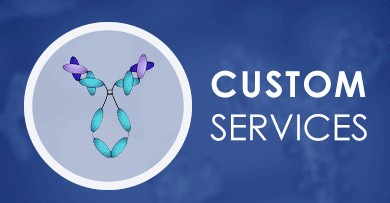 Loading...
Loading...

DDX17
 Loading...
Loading...Anti-DDX17 Products
-
- Species Reactivity: Human
- Type: Mouse antibody
- Application: WB
-
- Class: Class I
- Antigen: RNA-dependent helicase
- Antigen Species: Human
- Peptide: YLLPAIVHI
- Conjugate: PE
-
- Class: Class I
- Antigen: RNA-dependent helicase
- Antigen Species: Human
- Peptide: YLLPAIVHI
- Conjugate: APC
- PE-A2/Human DDX17 (YLLPAIVHI) MHC Tetramer (MHC-LC1957)
-
- Class: Class I
- Antigen: DDX17
- Antigen Species: Human
- Peptide: YLLPAIVHI
- Conjugate: PE
- Anti-DDX17 Immunohistochemistry Kit (VS-0325-XY642)
-
- Species Reactivity: Human, Mouse, Rat
- Target: DDX17
- Application: IHC
-
- Species Reactivity: Human, Mouse
- Type: Rabbit IgG
- Application: WB, IHC-P, ICC, IF, FC
- Anti-Rat DDX17 Immunohistochemistry Kit (VS-0525-XY1951)
-
- Species Reactivity: Human, Rat
- Target: DDX17
- Application: IHC
- Anti-Mouse DDX17 Immunohistochemistry Kit (VS-0525-XY1952)
-
- Species Reactivity: Human, Mouse
- Target: DDX17
- Application: IHC
- Anti-Human DDX17 Immunohistochemistry Kit (VS-0525-XY1950)
-
- Species Reactivity: Human
- Target: DDX17
- Application: IHC
-
- Derivation: Phage display library
- Species Reactivity: Human
- Type: Rabbit IgG
- Application: ICC, IF, FC, IHC-P, WB
Can't find the products you're looking for? Try to filter in the left sidebar.Filter By Tag
Our customer service representatives are available 24 hours a day, from Monday to Sunday. Contact Us
For Research Use Only. Not For Clinical Use.
Background
Enzymes, Plasma proteins
Intracellular
Low cell type specificity
Low immune cell specificity
Low cell line specificity
Interacts with DDX5 in an RNA-independent manner (PubMed:12595555, PubMed:19995069). Interacts with CDK9 transcription elongation complex under basal conditions. Following cell stimulation with poly(I:C), a synthetic double-stranded RNA mimicking viral infection, the interaction with CDK9 is decreased (PubMed:26209609). Interacts with ESR1 in an estrogen-independent manner (PubMed:19718048, PubMed:20663877). Interacts with HNRNPH1; this interaction is important for the regulation of alternative splicing on G-quadruplex structures (PubMed:24910439). At high, but not low, cell density, interacts with DROSHA and DGCR8, the core components of the microprocessor complex involved in the maturation of primary microRNAs (pri-miRNAs) into pre-miRNAs. The interaction with DGCR8 is reduced during mitosis (PubMed:24589731, PubMed:24581491). At low, but not high, cell density, interacts with YAP1 and with its paralog, WWTR1/TAZ. Interactions with DROSHA and YAP1 are mutually exclusive (PubMed:24581491). In vitro, the pre-miRNA processing activity of the DDX17-containing microprocessor complex is weaker than that of the DROSHA/DGCR8 microprocessor complex devoid of DDX17 (PubMed:15531877). Interacts with UPF3B (PubMed:23788676). Interacts with NFAT5; this interaction leads to DDX17 recruitment to LNC2 and S100A4 promoters and NFAT5-mediated DDX17-enhanced transactivation (PubMed:22266867). Interacts with HDAC1, HDAC2 and HDAC3; this interaction with HDAC1 and HDAC3, but not HDAC2, depends upon DDX17 acetylation (PubMed:15298701, PubMed:20663877). Interacts with ZC3HAV1 (via N-terminal domain) in an RNA-independent manner. Interacts with EXOSC3/RRP40 and EXOSC5/RRP46; this interaction may be indirect and mediated by ZC3HAV1-binding (PubMed:18334637). Interacts with EP300; this interaction leads to acetylation at lysine residues (PubMed:17226766, PubMed:19995069). Interacts with CREBBP/CBP and KAT2B/P/CAF (PubMed:17226766). Directly interacts with CTNNB1 (PubMed:17699760). Interacts with MYOD1 (PubMed:17011493). Interacts with TP53 (PubMed:15660129). Interacts with DCP1A in an RNA-independent manner. Interacts with DCP2 in an RNA-dependent manner (PubMed:21876179). Interacts with DHX36; this interaction occurs in a RNA-dependent manner (PubMed:18279852). Interacts with ERCC6 (PubMed:26030138).
Helicase, Hydrolase, RNA-binding



